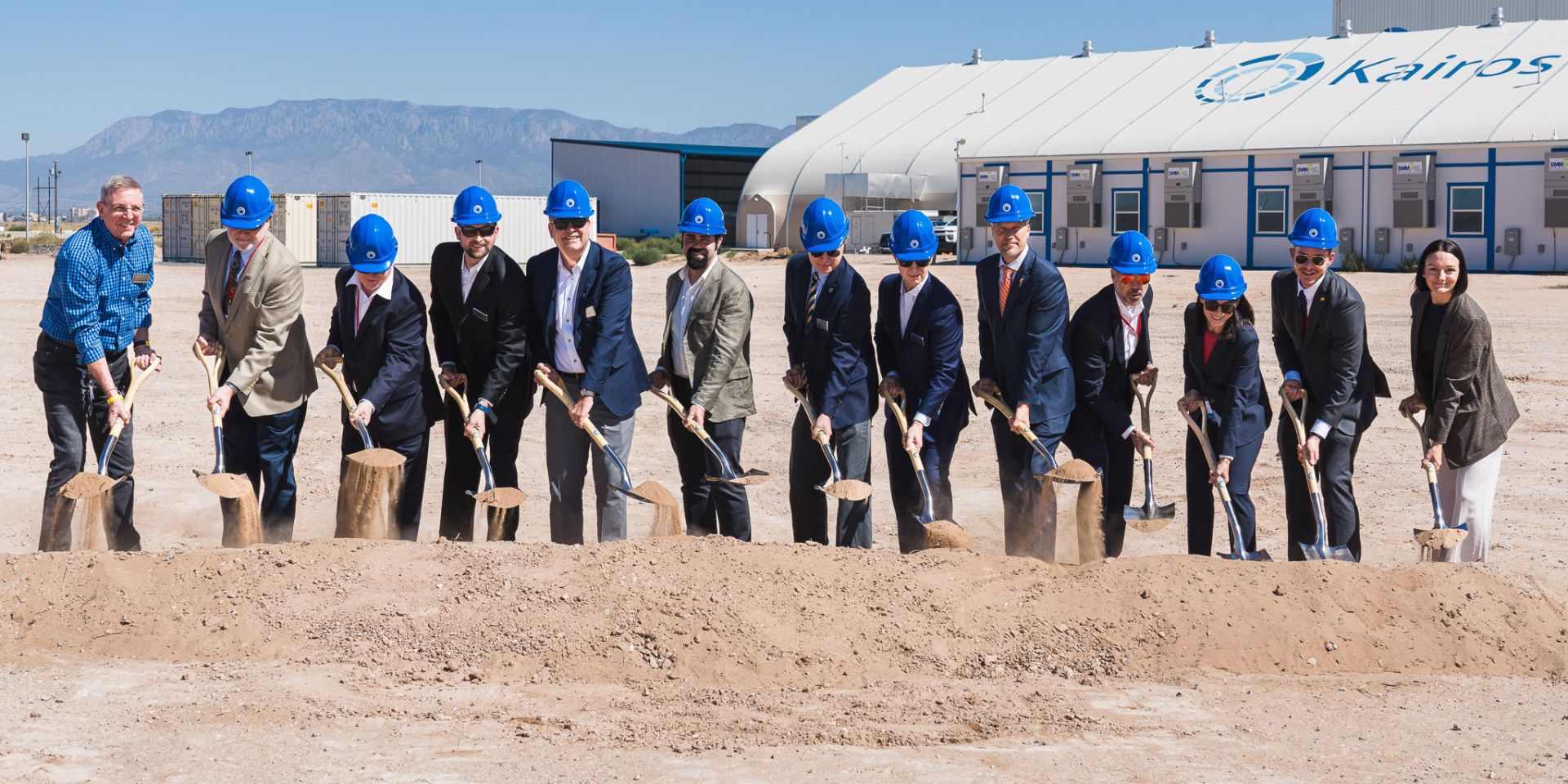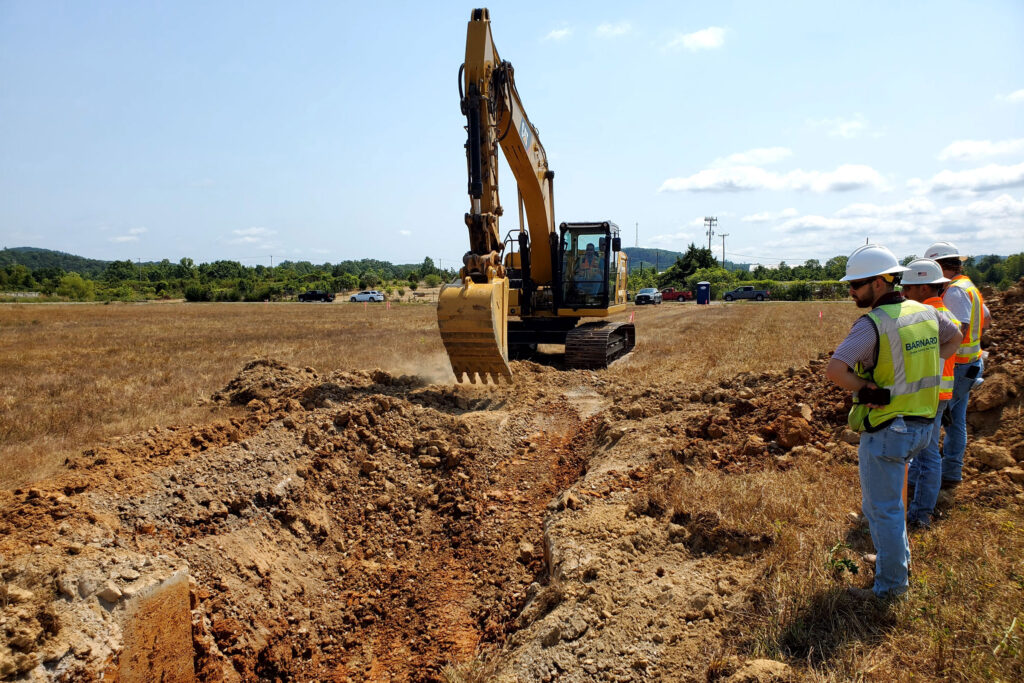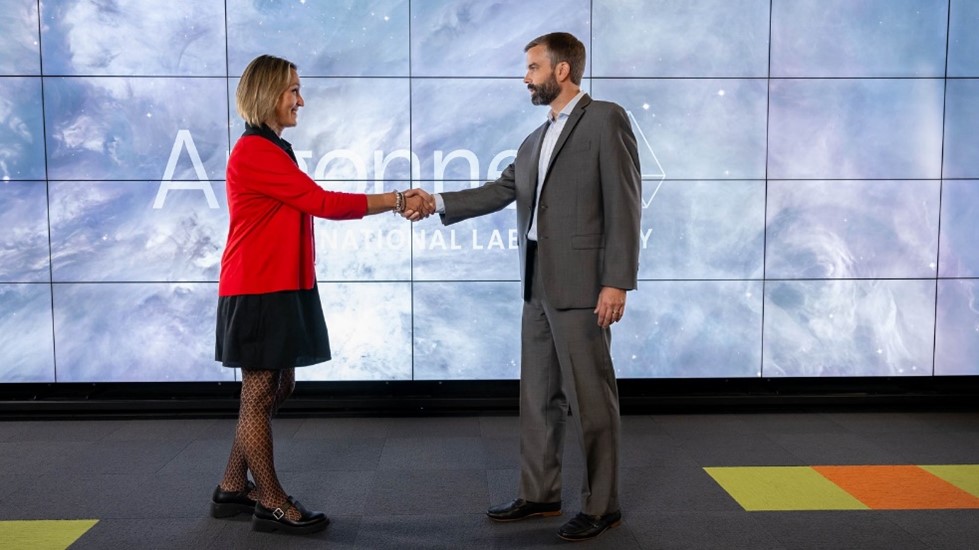Kairos Power leaders, elected officials, and key partners break ground on the Salt Production Facility at the company’s Manufacturing Development Campus in Mesa del Sol, N.M. (Photo: Kairos Power)
Kairos Power broke ground yesterday on a Salt Production Facility at the company’s newly dedicated Manufacturing Development Campus during an event at a sprawling site in Mesa del Sol, N.M., just south of Albuquerque. The new facility will produce the FLiBe (a mixture of lithium fluoride and beryllium fluoride salts) needed to cool the advanced reactors Kairos Power plans to build, starting with its Hermes nonpower demonstration reactor in Oak Ridge, Tenn., and could be operational and producing salt in 2026, according to an October 3 Department of Energy news release.
Workers begin construction at the Hermes site in Oak Ridge, Tenn. (Photo: Kairos Power)
Earlier today, on a site in Oak Ridge, Tenn., that was formerly home to the K-33 Gaseous Diffusion Plant, Kairos Power marked the start of construction on its low-power demonstration reactor. Named Hermes, the 35-MWt test reactor claims status as the first Gen IV reactor to be approved for construction by the Nuclear Regulatory Commission and the first non–light water reactor to be permitted in the United States in more than 50 years.
The former site of the K-33 gaseous diffusion enrichment plant in Oak Ridge’s East Tennessee Technology Park is the future site of Hermes and Hermes 2. (Photo: Kairos Power)
Nuclear Regulatory Commission staff has completed its final safety evaluation for Kairos Power’s application to build its Hermes 2 molten salt–cooled reactor test facility in Oak Ridge, Tenn., the agency announced July 22. Earlier, and independently, the NRC’s Advisory Committee on Reactor Safeguards (ACRS) reviewed safety-related aspects of the Kairos application and provided its review to the Commission on July 17. The evaluation concluded that there are no safety aspects that would preclude issuing a construction permit for the facility, but that can’t happen until the NRC staff issues its final environmental assessment later this summer and the Commission assesses the staff’s work (under newly streamlined procedures for mandatory hearings) this fall before voting on whether to authorize a construction permit.
Concept art for a Hermes plant. (Image: Kairos Power)
Kairos Power has received the go-ahead from the Nuclear Regulatory Commission to build its Hermes demonstration reactor at the Heritage Industrial Park in Oak Ridge, Tenn., making it the first non–light water reactor approved for construction in the United States in more than 50 years.
The U.S. Nuclear Regulatory Commission voted to issue a construction permit to Kairos Power for the Hermes demonstration reactor to be built in Oak Ridge, Tennessee.
WASHINGTON, D.C. — Statement from American Nuclear Society Executive Director and CEO Craig Piercy:
"Congratulations to Kairos Power from the American nuclear community on securing the first U.S. construction permit for a non-light water reactor in over 50 years. Kairos' regulatory milestone comes as COP28 climate negotiations go into overtime in Dubai. Kairos' achievement marks a pivotal step forward in scaling up advanced nuclear energy technologies required for a clean and resilient energy future. We look forward to the Hermes demonstration reactor breaking ground next year in East Tennessee."
Joint efforts of Argonne and private industry further nuclear reactor developments
Partnerships between the nuclear industry and national laboratories are making overall codes more robust and capable. (Photo: Argonne)
The development of modern nuclear reactor technologies relies heavily on complex software codes and computer simulations to support the design, construction, and testing of physical hardware systems. These tools allow for rigorous testing of theory and thorough verification of design under various use or transient power scenarios.
Kairos Power’s Hermes 2 demonstration plant (blue-topped building on the left) is planned to be built next to the Hermes demonstration reactor. (Image: Kairos Power)
A notice of opportunity from the Nuclear Regulatory Commission was published in the November 22 Federal Register to intervene in an adjudicatory hearing on Kairos Power’s application for a construction permit to build the Hermes 2 test reactor facility in Oak Ridge, Tenn.
The Engineering Test Unit at KP Southwest. (Photo: Kairos Power)
In October, staff at Kairos Power’s testing and manufacturing facility in Albuquerque, N. M., began transferring 14 tons of molten fluoride salt coolant into an Engineering Test Unit (ETU)—the largest transfer of FLiBe (a mixture of lithium fluoride and beryllium fluoride) since the Molten Salt Reactor Experiment in 1969.
Conceptual art of the Hermes low-power demonstration reactor. (Image: Kairos Power)
The Nuclear Regulatory Commission staff has completed its final environmental impact statement (FEIS) for Kairos Power’s application to build the Hermes demonstration reactor in Oak Ridge, Tenn., and is advising that the construction permit (CP) be issued.
“After weighing the environmental, economic, technical, and other benefits against environmental and other costs, and considering reasonable alternatives, the NRC staff recommends, unless safety issues mandate otherwise, that the NRC issue the CP to Kairos,” the FEIS states.
A rendering of the Hermes low-power demonstration reactor. (Image: Kairos Power)
Having completed its review of the construction permit application for Kairos Power’s Hermes test reactor early last month, the Nuclear Regulatory Commission’s Advisory Committee on Reactor Safeguards (ACRS) recently submitted its conclusions to the agency, recommending approval.
An artist’s rendering of Hermes. (Image: Kairos Power)
The Nuclear Regulatory Commission issued a draft environmental impact statement (EIS) recently on Kairos Power’s application for a permit to construct Hermes, a 35-MW nonpower version of the company’s fluoride salt–cooled reactor design (KP-FHR), at the East Tennessee Technology Park in Oak Ridge, Tenn.
How Kairos Power is applying rapid iterative development to the licensing process as part of its strategy to deliver on cost

Laufer
Developing a first-of-a-kind reactor is a daunting endeavor. To be successful, advanced reactor designers need to achieve cost certainty by delivering a safe and affordable product at the promised cost. To meet this goal, Kairos Power structured its approach around four key strategies: 1) achieving technology certainty through a rapid iterative approach; 2) achieving construction certainty by demonstrating the ability to build it; 3) achieving licensing certainty by proving Kairos can license it; and 4) achieving supply chain certainty by vertically integrating critical capabilities. By mitigating risk in these four key areas, Kairos Power is confident that it will get true cost certainty for our future products.
The third prong in Kairos’s strategy—achieving licensing certainty—was a key driver in the decision to build the Hermes low-power demonstration reactor, and it remains a major workstream as the company’s construction permit application (CPA) undergoes review by the U.S. Nuclear Regulatory Commission. Licensing a new nuclear technology is no small challenge, and there are multiple approaches companies can take. Here’s a look at how we at Kairos are approaching it.

















